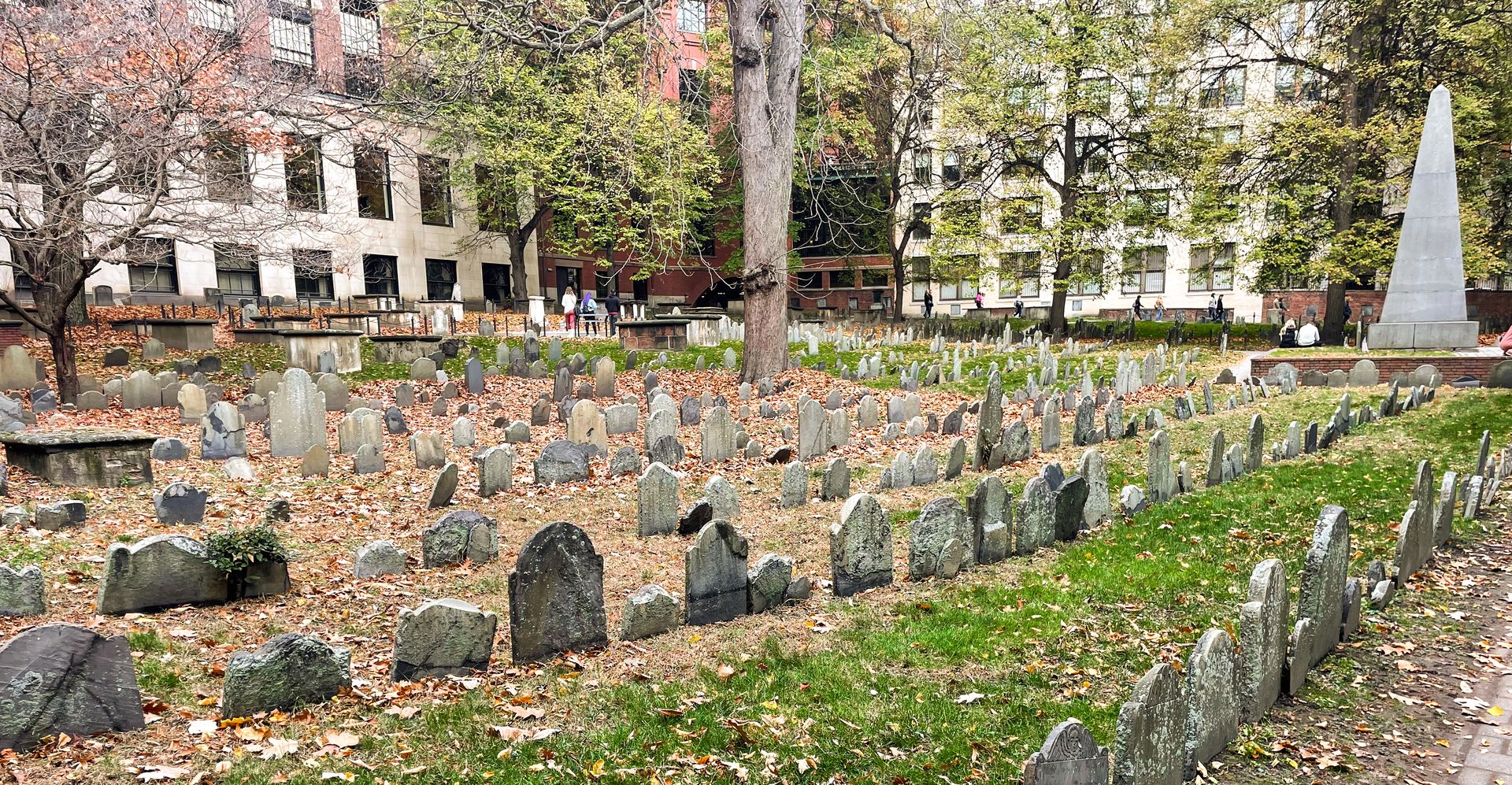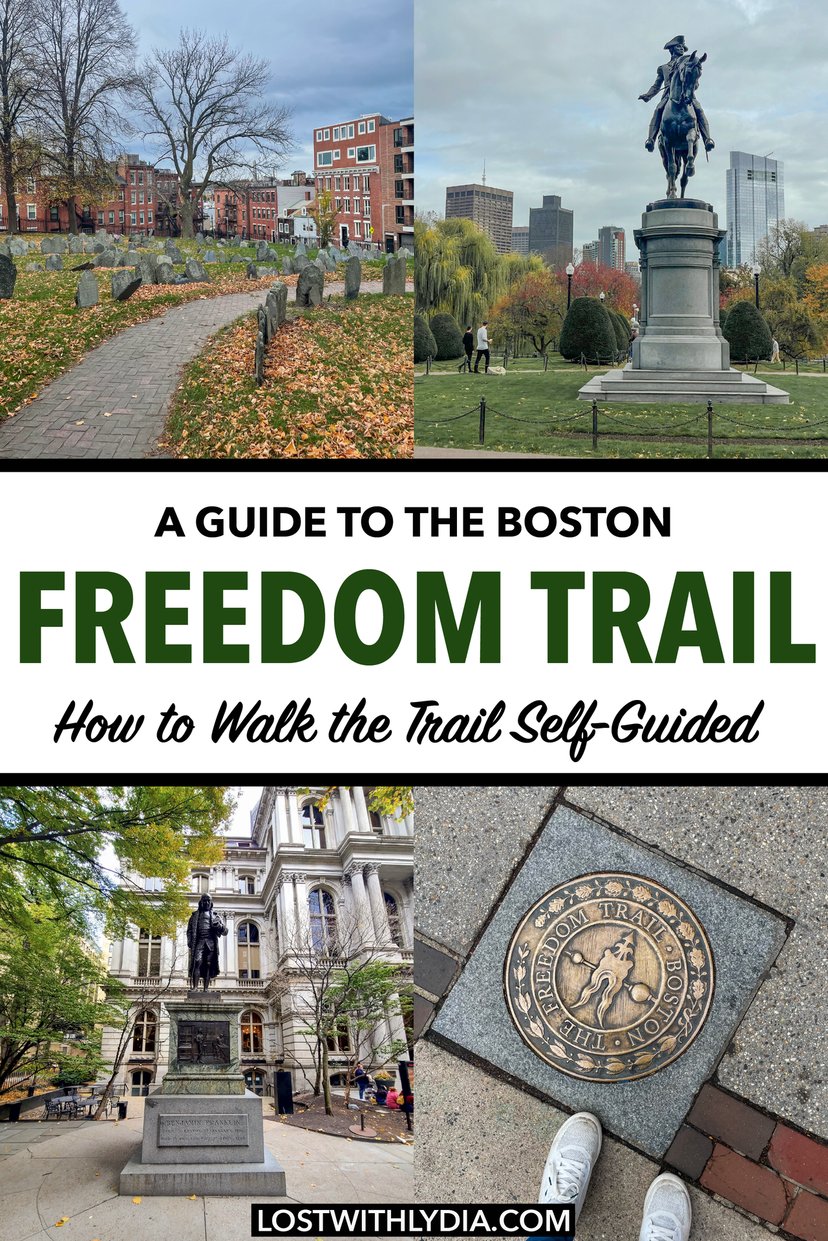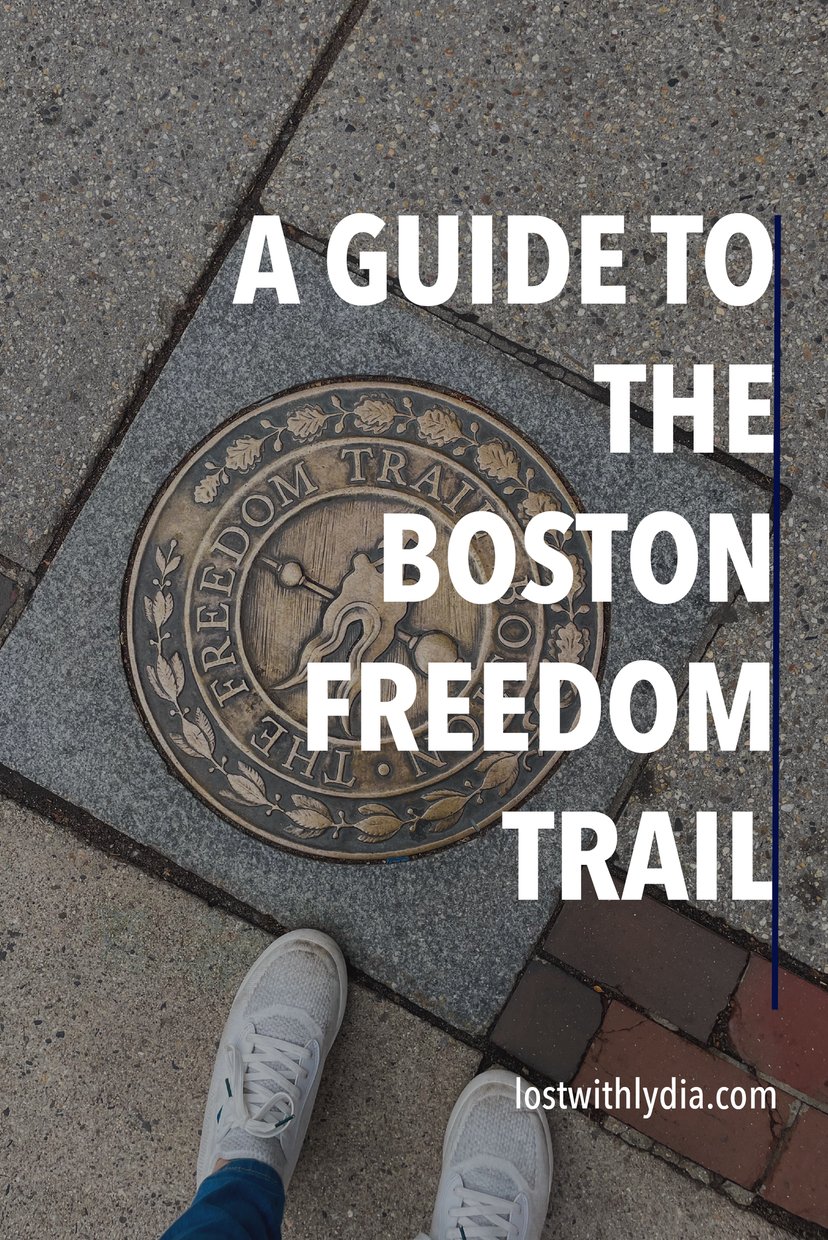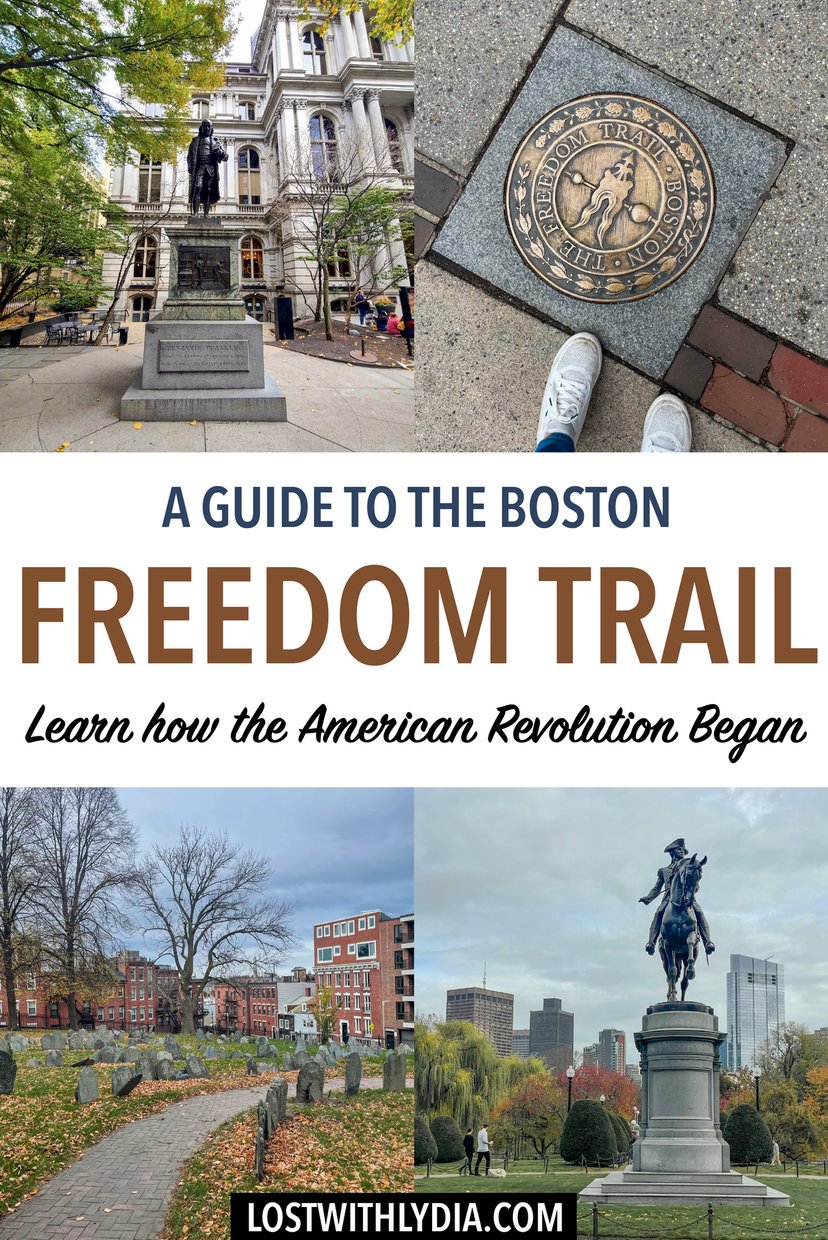If you’re interested in discovering the history of Boston and the United States, the Boston Freedom Trail is one of the best ways to do it. Boston played a central role in the American Revolution. Several important events that lead to the Revolution took place here, such as the Boston Tea Party, the Boston Massacre, and many more.
The Freedom Trail is a 2.5-mile urban path that will lead you to 16 historically significant locations in United States history. The route is marked on the sidewalks with red bricks. You can walk the entire trail for an urban hike, take a tour, or visit only some of the sights. No matter how you visit, the Freedom Trail is a fantastic way to learn more about the early history of the formation of the United States, and one of the best things to do in Boston.
Taking a Tour of the Freedom Trail vs. Going Self-Guided
If you’d like to learn about the Freedom Trail from a guide, there are a few different types of tours to choose from.
The official freedom trail walking tour features guides dressed up in period clothing. It lasts 1.5 hours and includes 11 of the stops on the Freedom Trail.
The Freedom Trail Foundation also offers a lantern tour, an African American patriots tour, a Revolutionary Women tour, a historic pub crawl, and more.
There are also some ranger-led talks and tours led by the national park service. Topics include the Underground Railroad, Bunker Hill, the tea party and more.
I opted to explore the Freedom Trail self-guided and was able to walk between all of the stops in one day. However, a tour or a ranger-led talk is a great way to learn more details about the founding of the United States.
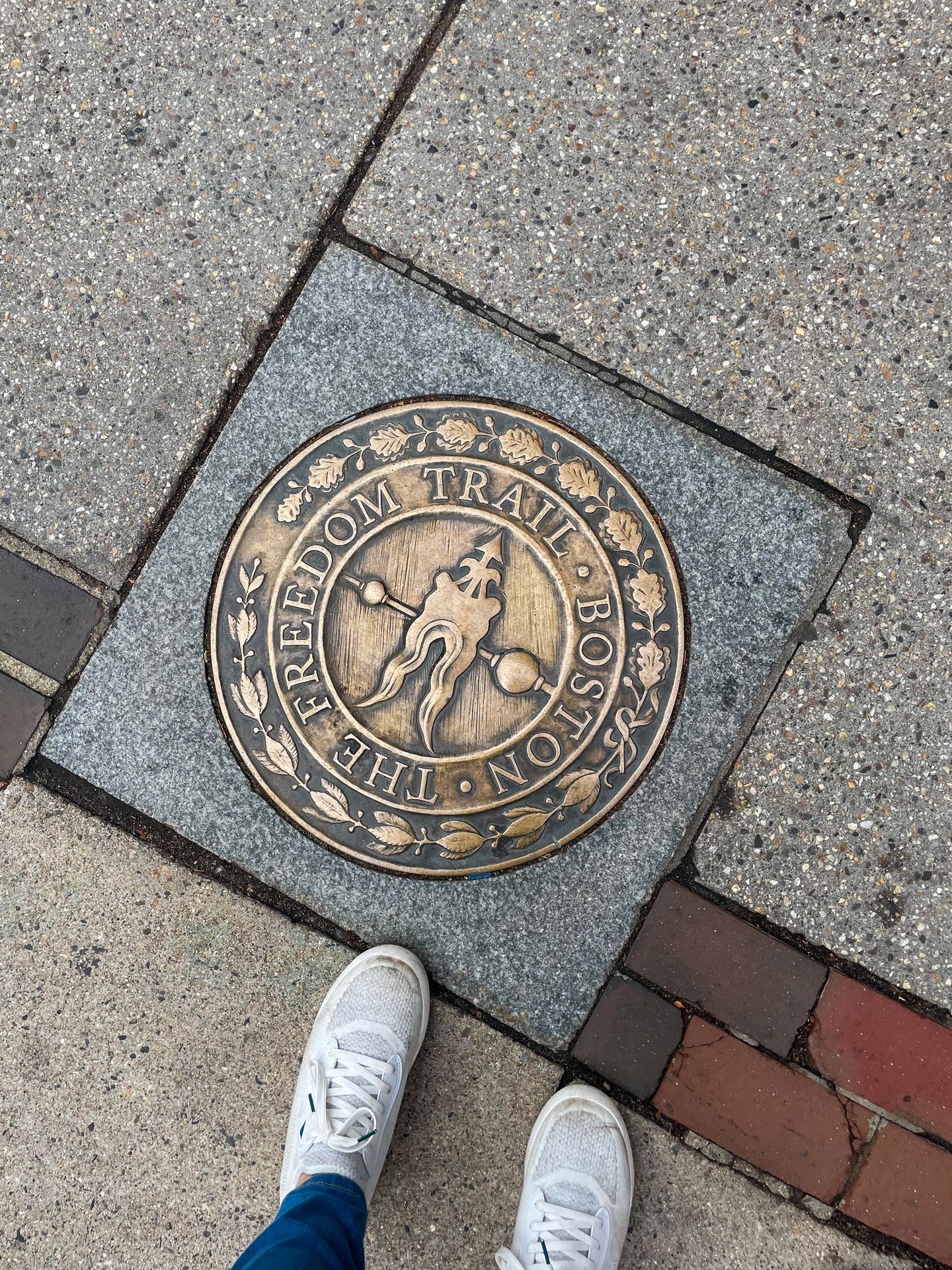
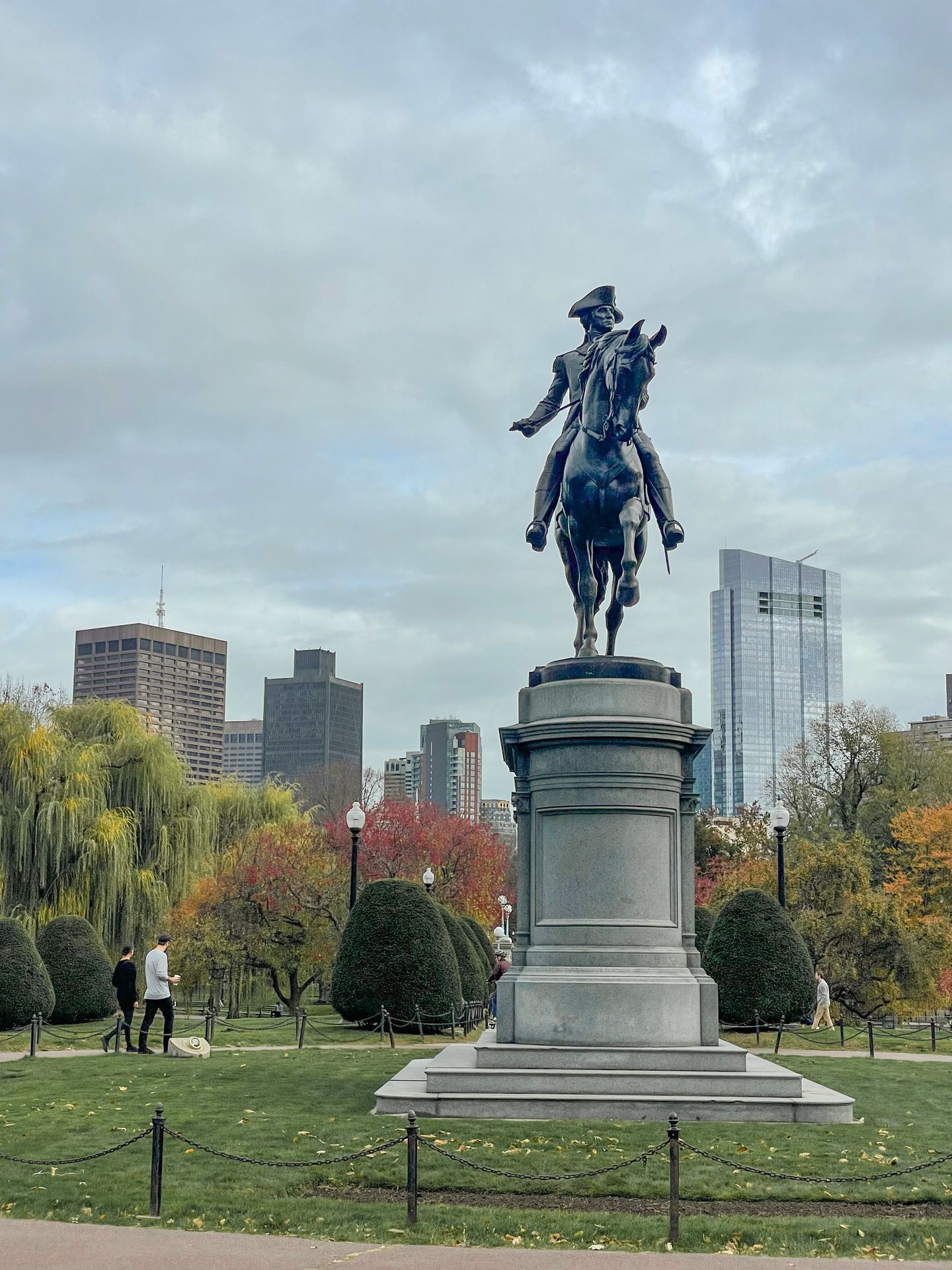
Overview of the Boston Freedom Trail
The Freedom Trail has 16 stops, and the route between them is 2.5 miles. Here is a list of the stops, and then I’ll go into more detail about each one. They are listed in order from the start to the end of the trail.
- Boston Common
- Massachusetts State House
- Park Street Church
- Granbury Burying Ground
- King’s Chapel and King’s Chapel Burying Ground
- Boston Latin School Site
- Old Corner Bookstore
- Old South Meeting House
- Old State House
- Boston Massacre Site
- Faneuil Hall
- Paul Revere House
- Old North Church
- Copp’s Hill Burying Ground
- USS Constitution
- Bunker Hill Monument
Tip: Download the free Freedom trail brochure to read about the various locations along the way. Or, download the Guide Along tour if you prefer an audio tour.
How long do you need to walk the Boston Freedom Trail?
I recommend allowing almost a full day to experience the Boston Freedom Trail self-guided. Personally, I spent about 5 and a half hours walking the trail, going into some of the sites (but not all), and stopping for lunch. You could easily spend longer if you want to go into every site.
Map of the Boston Freedom Trail
Here is a map of the Freedom Trail provided by the Freedom Trail Foundation. There is also an AllTrails route that you can follow.

All of the Stops on the Boston Freedom Trail
Boston Common
The first stop on the Freedom Trail is Boston Common, which happens to be America’s oldest public park.
Fun Fact: Boston Common was established in 1634.
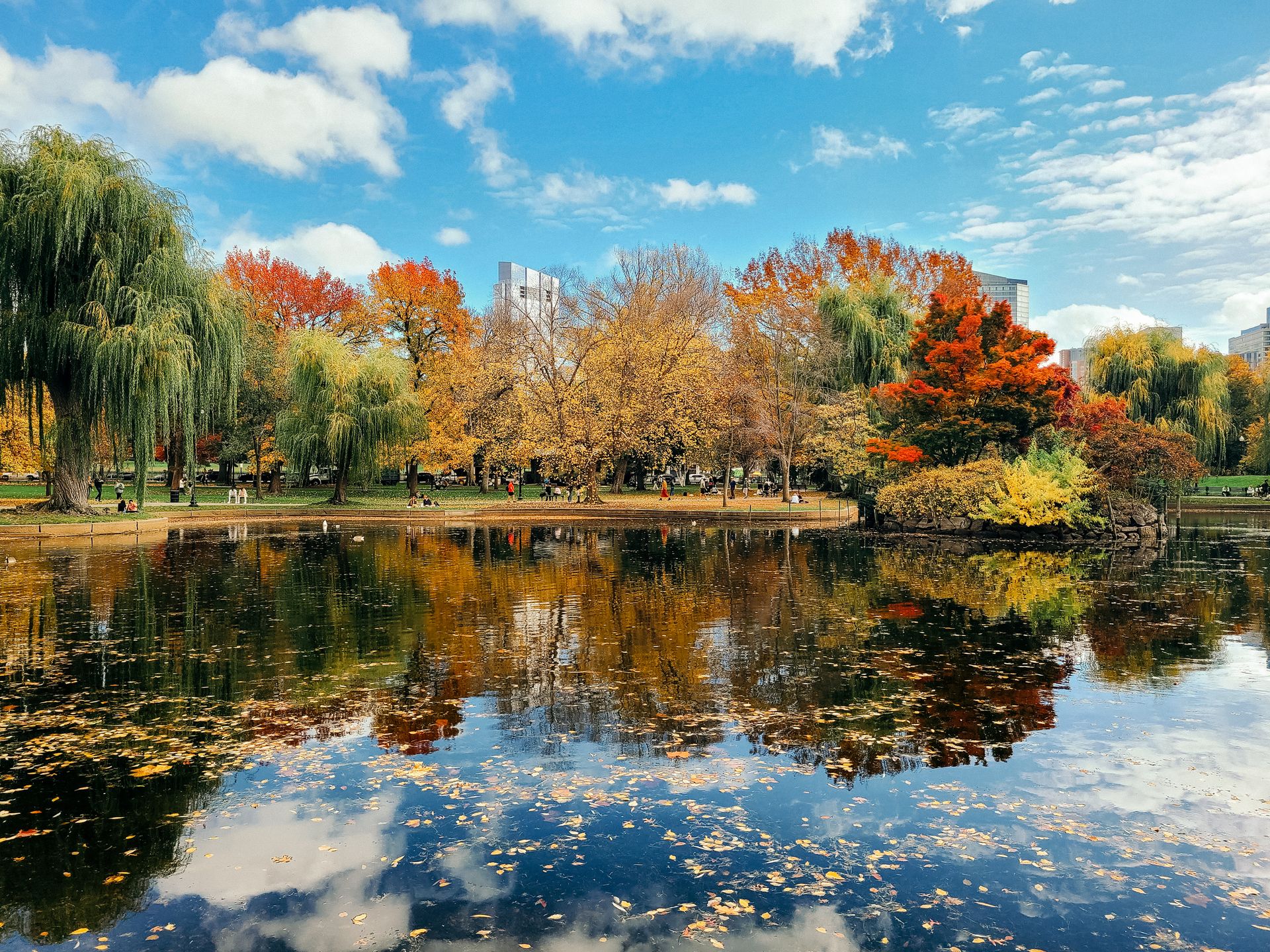
The land for the park was purchased by Puritan colonists and used as a “Common Land” for local livestock until 1830. Later on, the land was used as a “trayning field” for Redcoats during their occupation of Boston in 1775. Since then, the land has been used in many instances for discourse and public demonstrations, such as a civil rights rally held by Martin Luther King Jr, Vietnam War protest rallies, a Mass by Pope John Paul II and more.
The Freedom Trail officially begins here in the park at the Boston Common Visitor Center. The visitor center has souvenirs, restrooms and informational brochures. Before you begin your walk on the Freedom Trail, it’s nice to explore the park a bit.
Inside the park, don’t miss the Public Garden, where you’ll see sculptures, a pond and beautiful landscaping. This area is actually located across the street from Boston Common and offers Swan Boats to drive around the pond in the warmer months.
Also take a look at the Earl of Sandwich, a unique building that was formerly used as a men’s restroom in the early 1900’s. The fast food sandwich chain spent over a million dollars to renovate the building to what it is today.
After exploring the park, follow the red bricks from the visitor center to the Massachusetts State house as you begin your historic walk around Boston.
Massachusetts State House
The Massachusetts State House opened in 1798 and houses the Massachusetts legislative and executive branches. The building is free to enter on weekdays, but closed on weekends and holidays. If you schedule in advance, you can also take a free tour of the state house.
Fun Fact: This is the fourth oldest US state capitol building.
Since I visited on a weekend, I enjoyed the view from outside and then continued to stop number three.
Park Street Church
The Park Street Church is an historic site in Boston that is over 200 years old. It was founded in 1809 and was once one of the first landmarks a visitor would see on their trip to Boston.
The church has served as a place for talks of prison reform, women’s suffrage and impassioned protests against slavery. The church also held onto brimstone (a part of gunpowder) in the basement during the War of 1812.
Typically, the church is only open during the summer months, but they also offer Sunday Services open to all.
Granbury Burying Ground
Right next door to the Park Street Church, you’ll find the Granbury Burying Ground. In my opinion, this is one of the most interesting stops on the trail. The cemetery has the gravestones of many notable figures, including John Hancock, Samuel Adams, Paul Revere and the parents of Benjamin Franklin. This is also a grave marker for the victims of the Boston Massacre.
The site is named after the 12,000-bushel grain storage that used to be next door. There are about 2,300 grave markers in the site, and many have depictions of the afterlife, such as skulls and the Grim Reaper.
This site is typically open from 9 AM to 4 PM and is free to enter.
This historic burying ground is not to be missed while exploring the Freedom Trail.
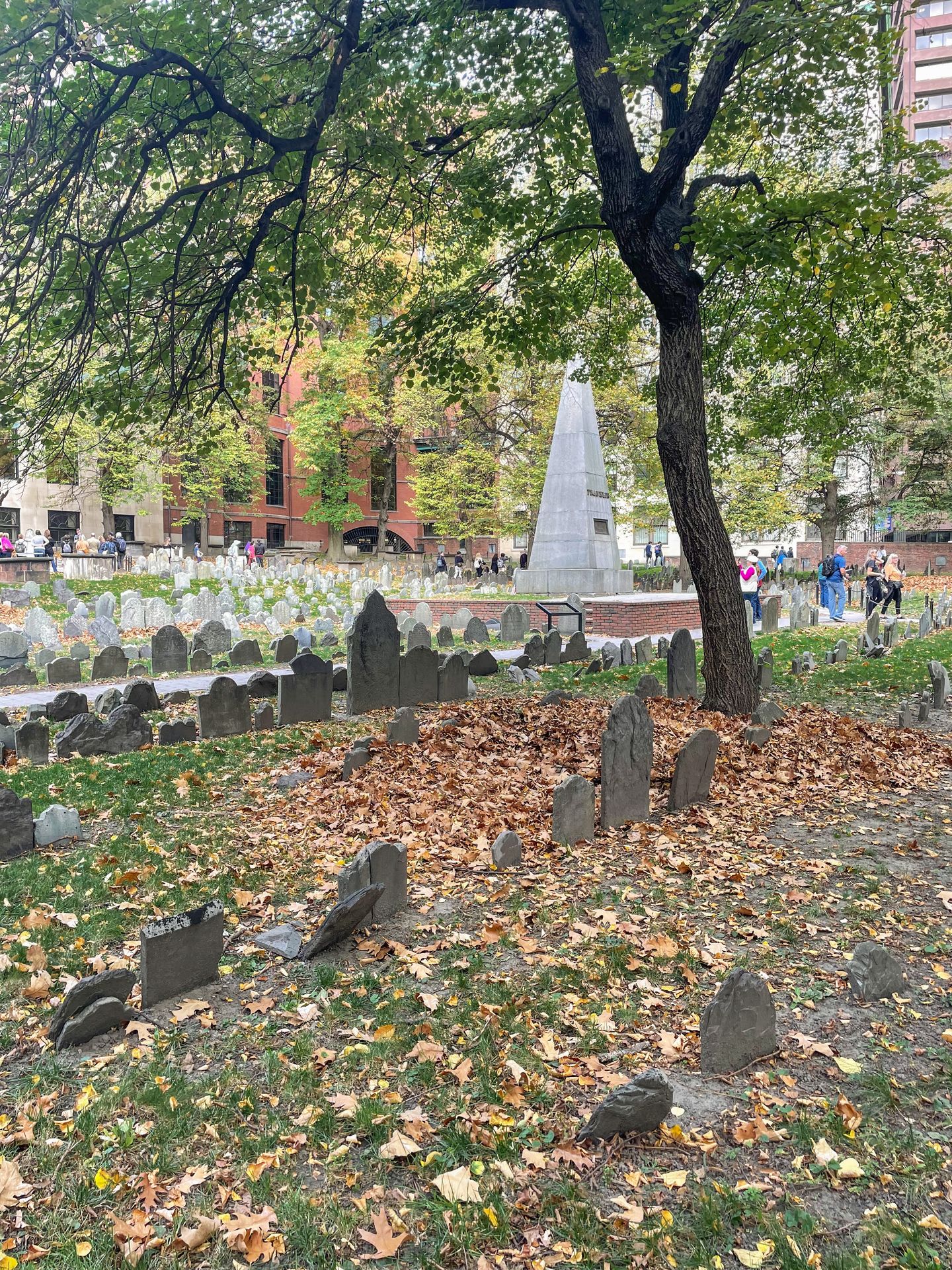
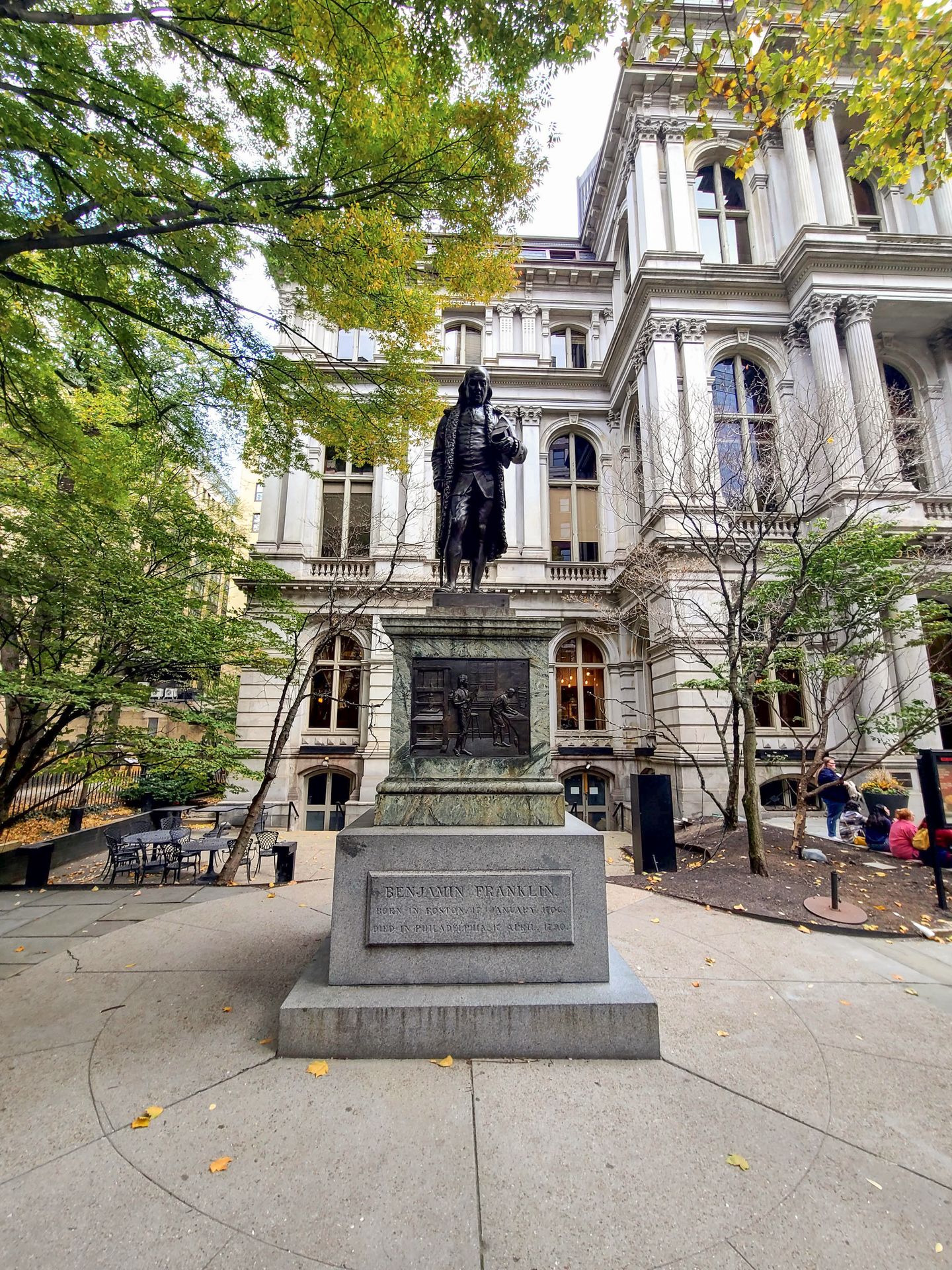
King’s Chapel and King’s Chapel Burying Ground
King’s Chapel and King’s Chapel Burying Ground are located right down the street from Granbury Burying Ground and Park Street Church. The cemetery is free to visit, but it costs $5 to enter the chapel. The burying ground was the first one in Boston and is the home of John Winthrop, Mary Chilton (the first woman to step off the Mayflower) and others.
Fun Fact: The church has the oldest American pulpit still in continuous use.
I did not pay to enter the chapel but it is one of the oldest churches in Boston and has multiple exhibits to explore.
Boston Latin School Site
Behind the King’s Chapel, you’ll find a square, statue and mosaic that mark the location of what was once the Boston Latin School. The school was founded in 1635 and is the oldest public school in America.
The school offered free education to boys that were both rich and poor. However, girls were not allowed.
Five signers of the Declaration of Independence attended Boston Latin. Benjamin Franklin was one of them, but he actually dropped out. Despite that, a statue of Benjamin Franklin marks the location of the former schoolhouse. The school still operates today in other locations around the city.
Old Corner Bookstore
This stop on the Freedom Trail is just a quick destination to admire, as it no longer exists. It’s the site of the Old Corner Bookstore and is Boston’s oldest commercial building. It was home to the publisher Ticknor and Fields, which produced notable titles such as The Scarlet Letter, Walden and more.
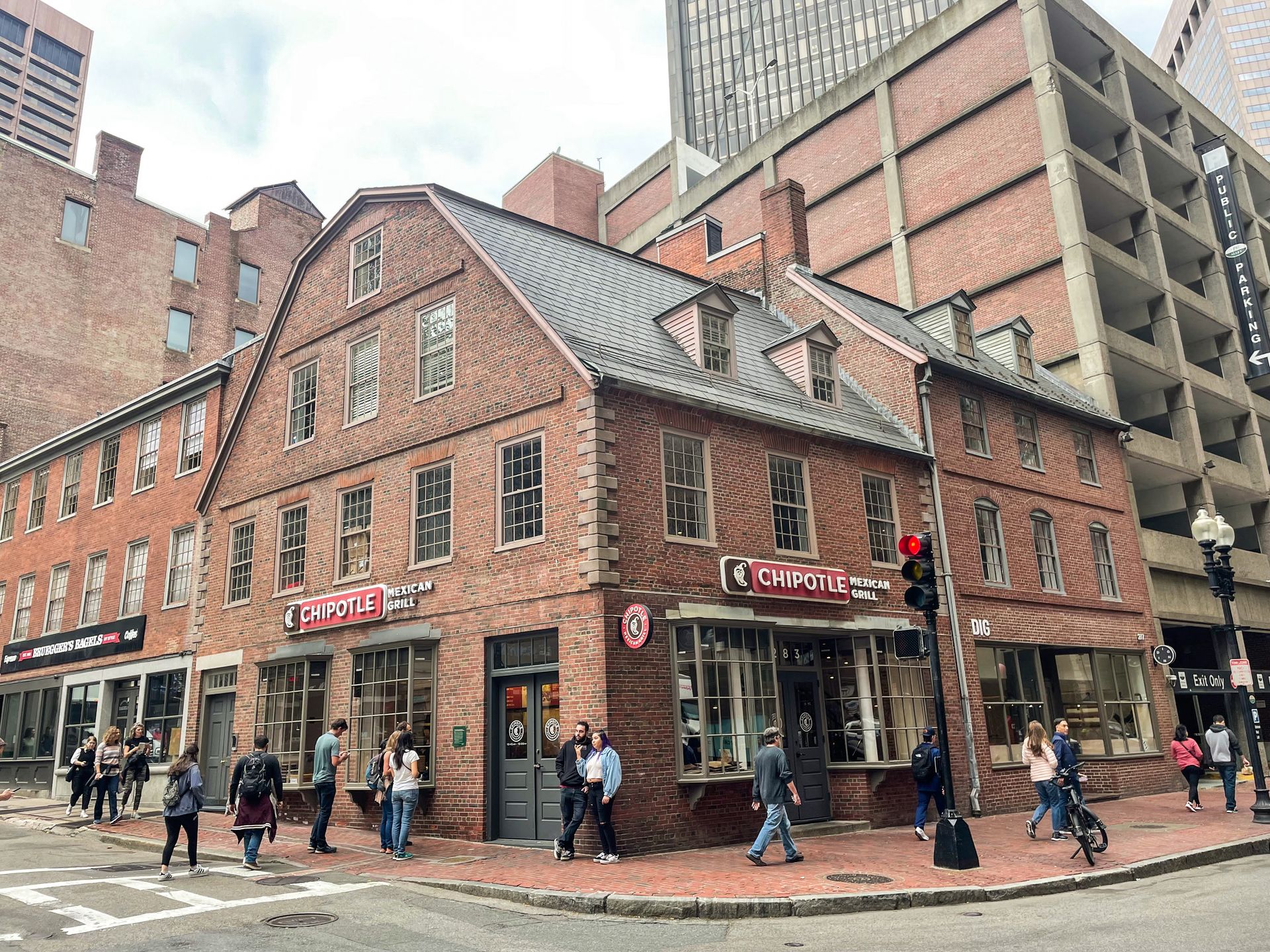
Fun Fact: The leases of this building help subsidize the cost of historic preservation projects in Boston.
It was originally constructed in 1718 and saved from demolition in 1960. Today, the building is a Chipotle, and if I’m being honest, the giant “Chipotle” signs take away from the historic appeal. However, it’s also an example of how history is intermixed into modern day Boston.
Old South Meeting House
Almost across the street from the Old Corner Bookstore is the Old South Meeting House. This is the location of many important meetings and protests against British actions leading up to the revolution. Most notably, this is where 5,000 men debated the controversial tea tax in 1773. When they could not compromise, Samuel Adams gave the signal to begin the Boston Tea Party. This major event led to the start of the American Revolution.
Fun Fact: The Old South Meeting House has been a public museum since 1877.
The Old South Meeting House is a partner site of the Boston National Historical Park and costs $15 per adult. The same ticket can be used at the Old State House. I opted not to go inside, but there are some interesting exhibits about the history.
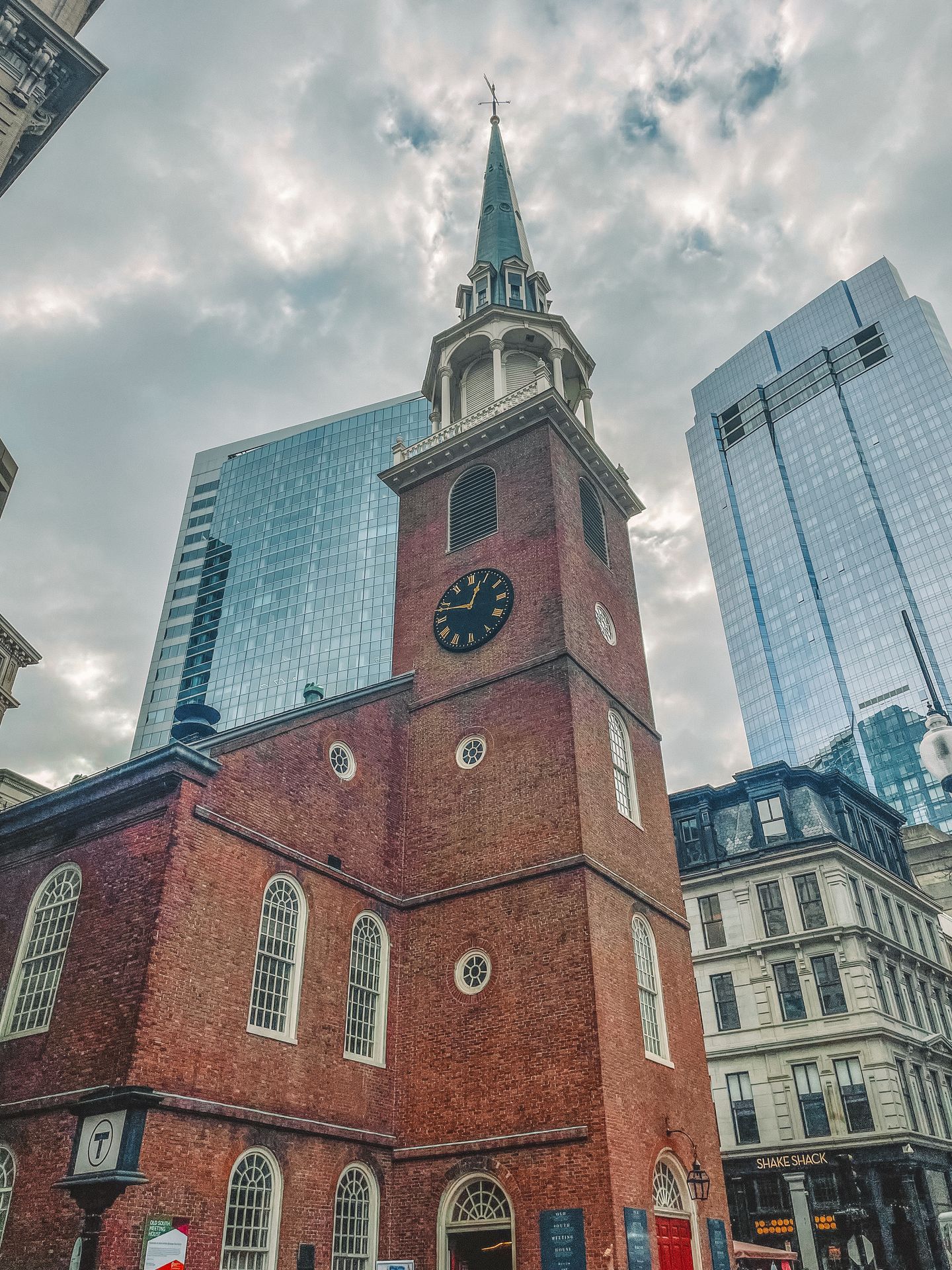
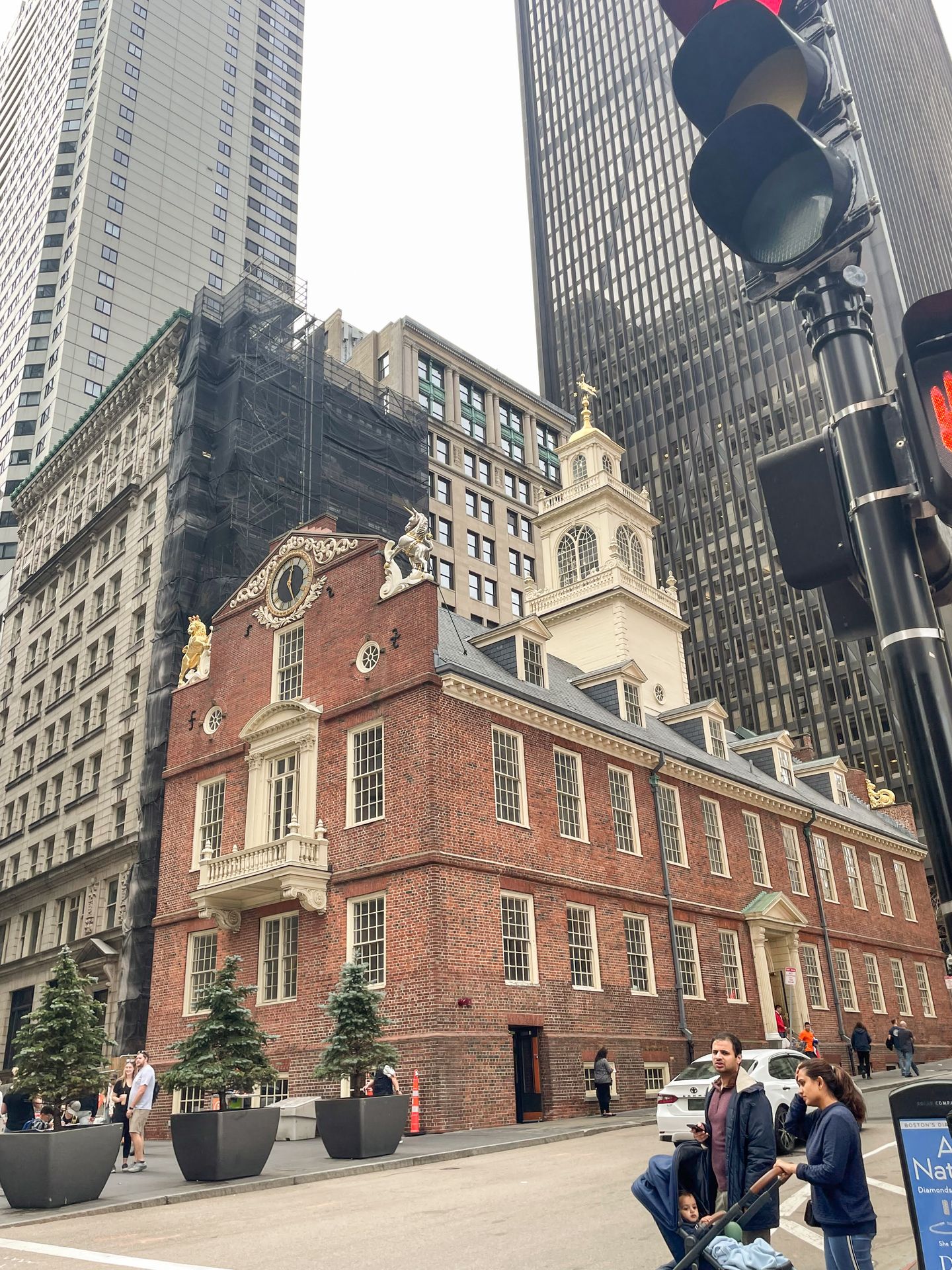
Old State House
The Old State House is the oldest surviving public building in Boston. The building was first built in 1713 and served as a center for public life. The Boston Massacre occurred just outside of this building.
The museum tells of the events that led up to the Revolutionary War and includes historic period rooms and several important artifacts. You can see John Hancock’s red velvet coat, ammunition from Revolutionary War battles and tea from the Boston Tea Party. It costs $15 to enter and can also be used at the Old South Meeting House.
Boston Massacre Site
The Boston Massacre Site is right outside of the Old State House and free to visit. This event occurred in 1770 when British soldiers fired on a crowd of people, killing five of them. The shots were fired in response to the angry mob throwing stones and snowballs at the soldiers. The image depicting this event was shared widely to garner support for the Revolution.
This event was an important catalyst in sparking the start of the revolution, as many Bostonians rallied behind the injustice that occurred here.
Today, there is a large marker on the sidewalk where the massacre took place.
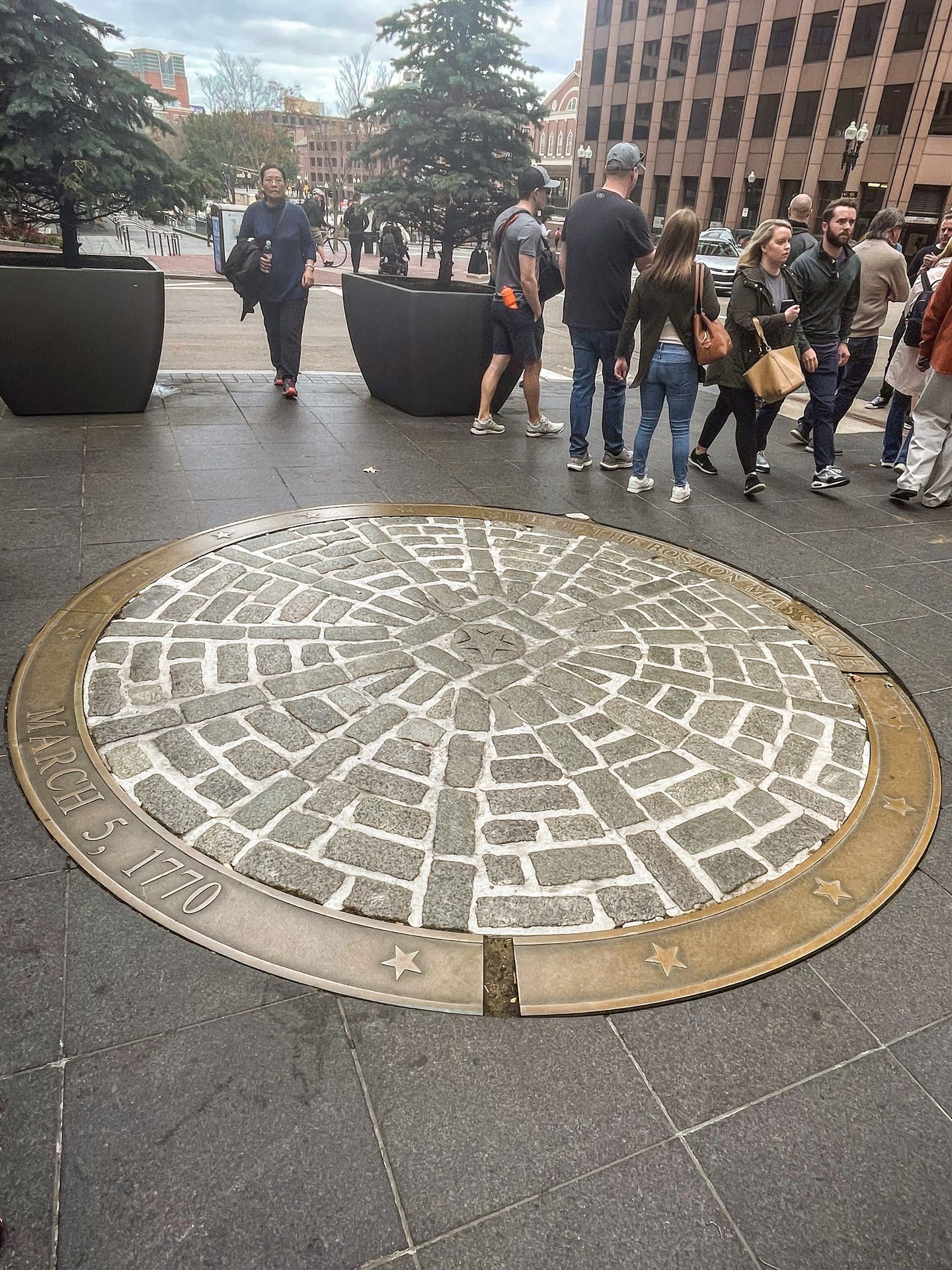
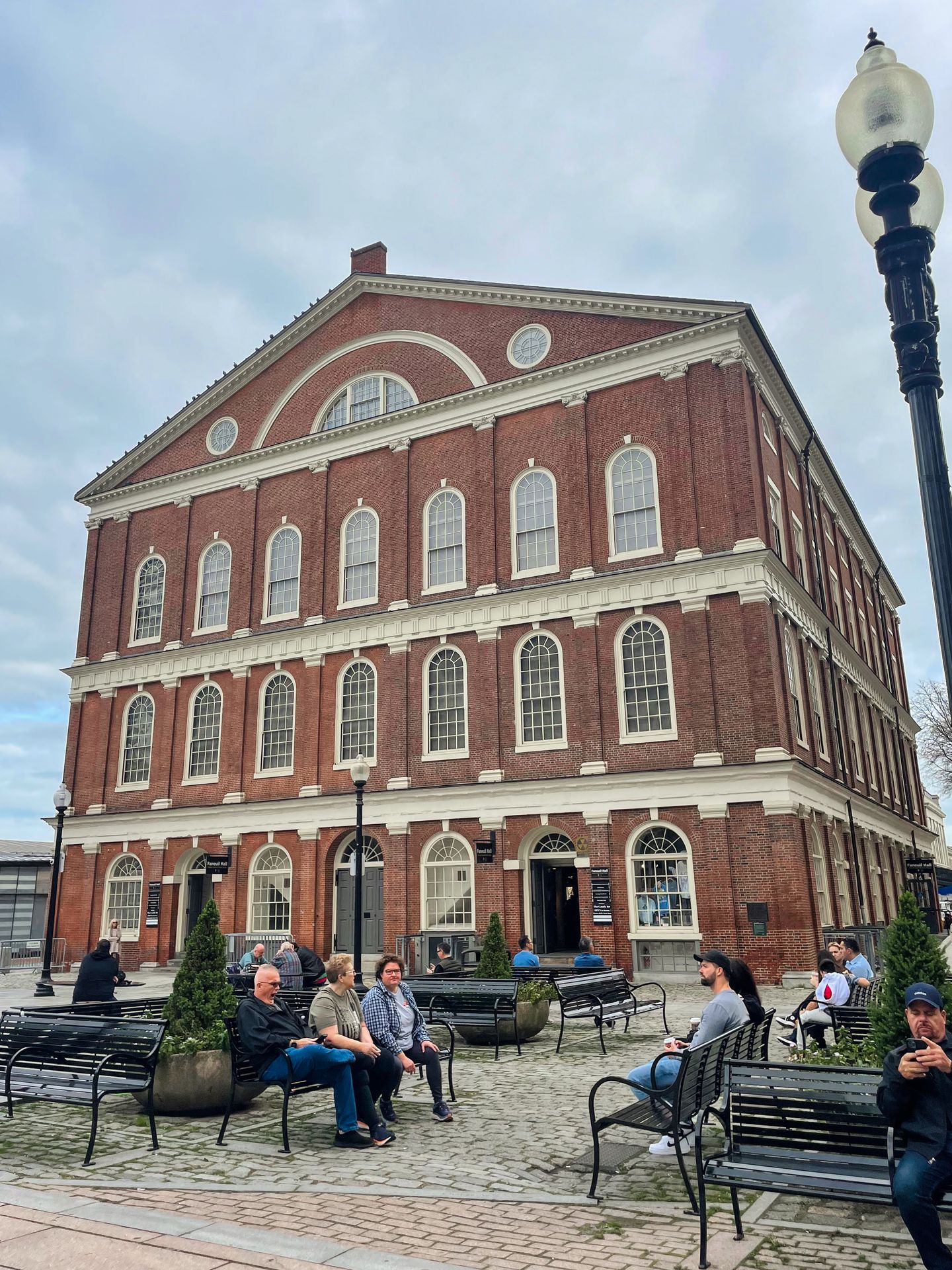
Faneuil Hall
Faneuil Hall was a center of commerce and a forum of free speech for many years. It is where the Sons of Liberty discussed their dissent against the British, where Americans first protested the Sugar Act and the site of other important discussions.
Fun Fact: Faneuil Hall hosted America's first Town Meeting.
Today, you’ll find the Fauneuil Hall Marketplace and Quincy Market right next door to the historic Faneuil Hall. The Fauneuil Hall Marketplace has several vendors with souvenirs. You can also pick up a National Park site map of the Freedom Trail and learn more about the trail through some National Park exhibits.
The historic Quincy Market first opened in 1823 and is a center for eating and shopping. You can find lobster rolls, clam chowder and much more.
Personally, I found Quincy Market to be very crowded and overwhelming. The architecture is beautiful, but it gets extremely busy during peak times. With that in mind, I preferred Boston Public Market for lunch.
Paul Revere House
Continuing on the Freedom Trail, your next stop is the Paul Revere House. This is where Paul Revere lived and it’s the oldest remaining structure in Downtown Boston.
There isn’t much to see outside, so I paid to go inside. You get to walk through a few rooms in the home and learn a bit about the life of Paul Revere. There is information on Revere’s family life, his business ventures and the story of the midnight ride in his own words. There are also historic artifacts
You cannot take photos inside, but you can in the courtyard. At this writing, tickets are $6 per adult. The museum is small but worth a quick visit for the affordable price.
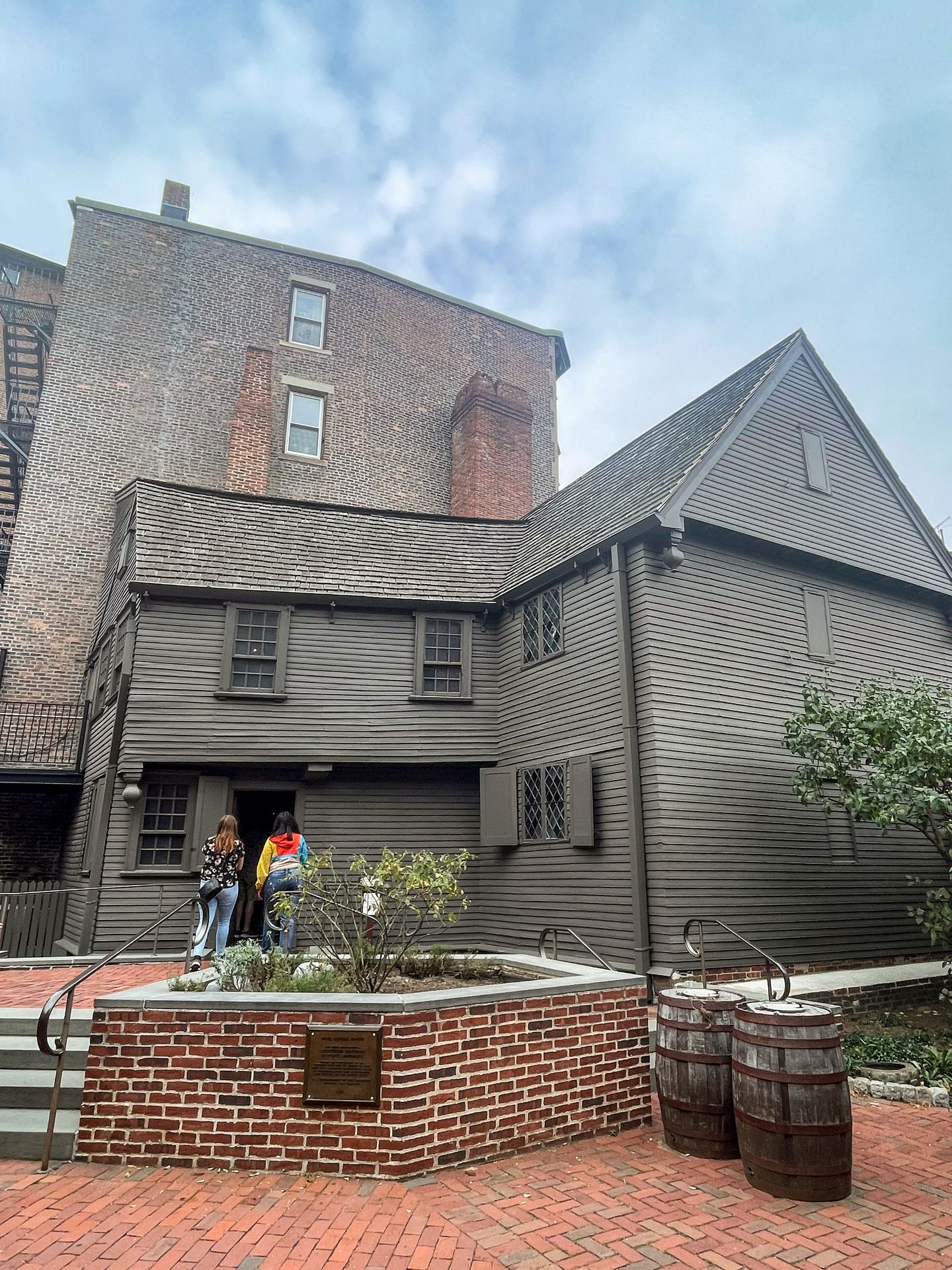
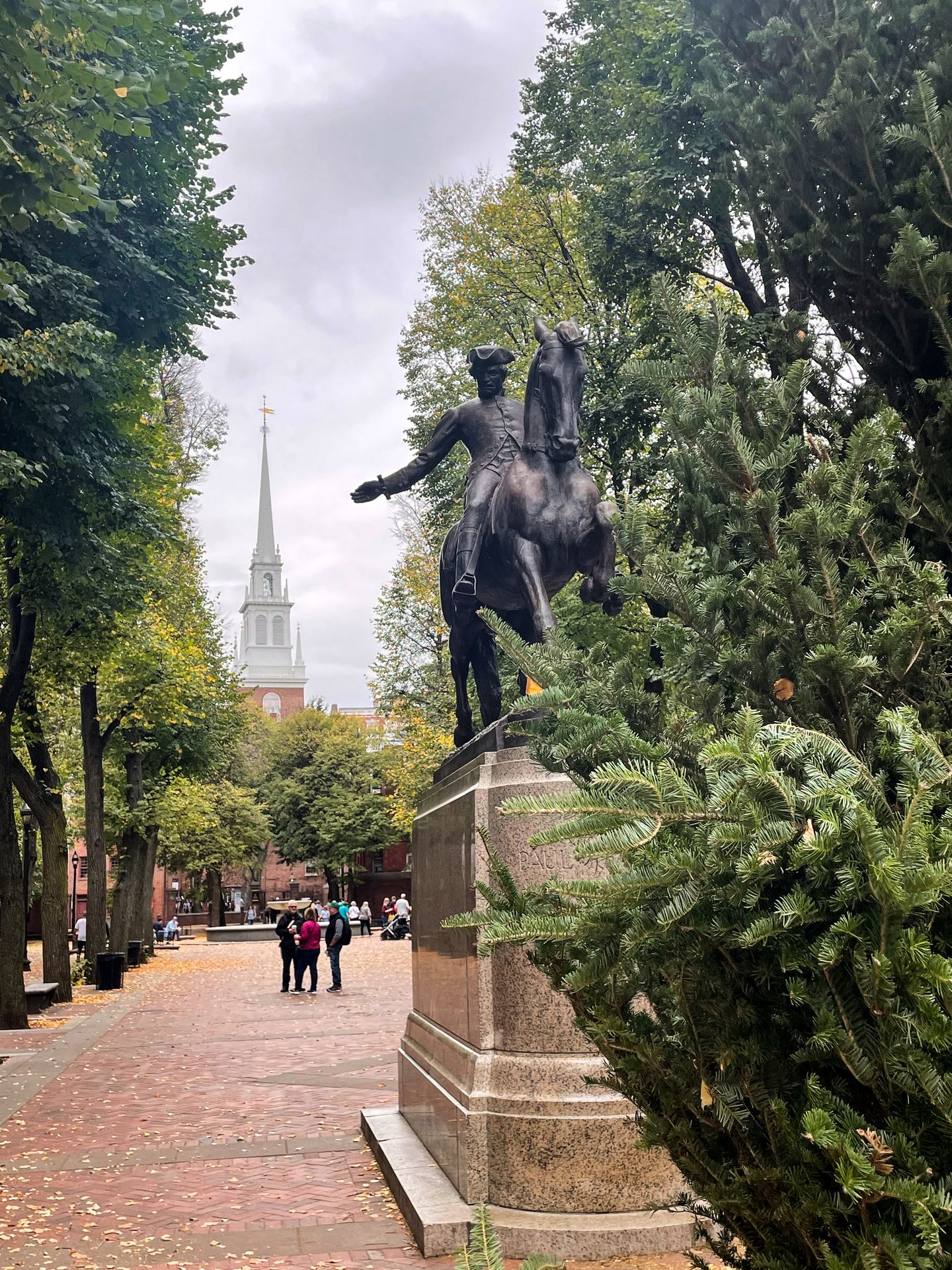
Old North Church
The Old North Church is the oldest church in Boston and is most known as the site where two lanterns were hung to signify that the British were coming during Paul Revere's Midnight Ride. The lanterns signified the route of the British: “One if by land, two if by sea.”
There is a $5 fee to see the interior of the church, or you can pay a little more to see the crypt or the ringing bell chamber.
In front of the church, you’ll walk through Paul Revere Mall, which has a fountain, benches and a statue of Paul Revere on a horse. It’s a lovely place to rest before walking the rest of the Freedom Trail.
Copp’s Hill Burying Ground
Copp’s Hill is your last stop on the Freedom Trail before crossing the Charles River into Charlestown! This is the burial site of some important figures who lived on the North End.
It also provides an elevated view of the surrounding area. In fact, the British used the cemetery as a vantage point to aim their cannons towards Charlestown during the Battle of Bunker Hill.
Tip: Also look for the Skinny House across the street from Copp’s Hill Burying Ground. The house is 10.4 feet at its widest point!
As you continue on the Freedom Trail, the official route will take you over the North Washington Street Bridge. As a slight detour, I recommend walking over the Gridley Locks Footpath instead.
If you’re unfamiliar with a lock, it’s a navigation device to raise and lower boats between different water levels. This lock is still in use as ships navigate between the Charles River and the Boston Harbor.
There is a sidewalk here where you can actually walk over the doors of locks, as long as they are not in use. The locks are a fun and quick add on to your day walking the Freedom Trail.
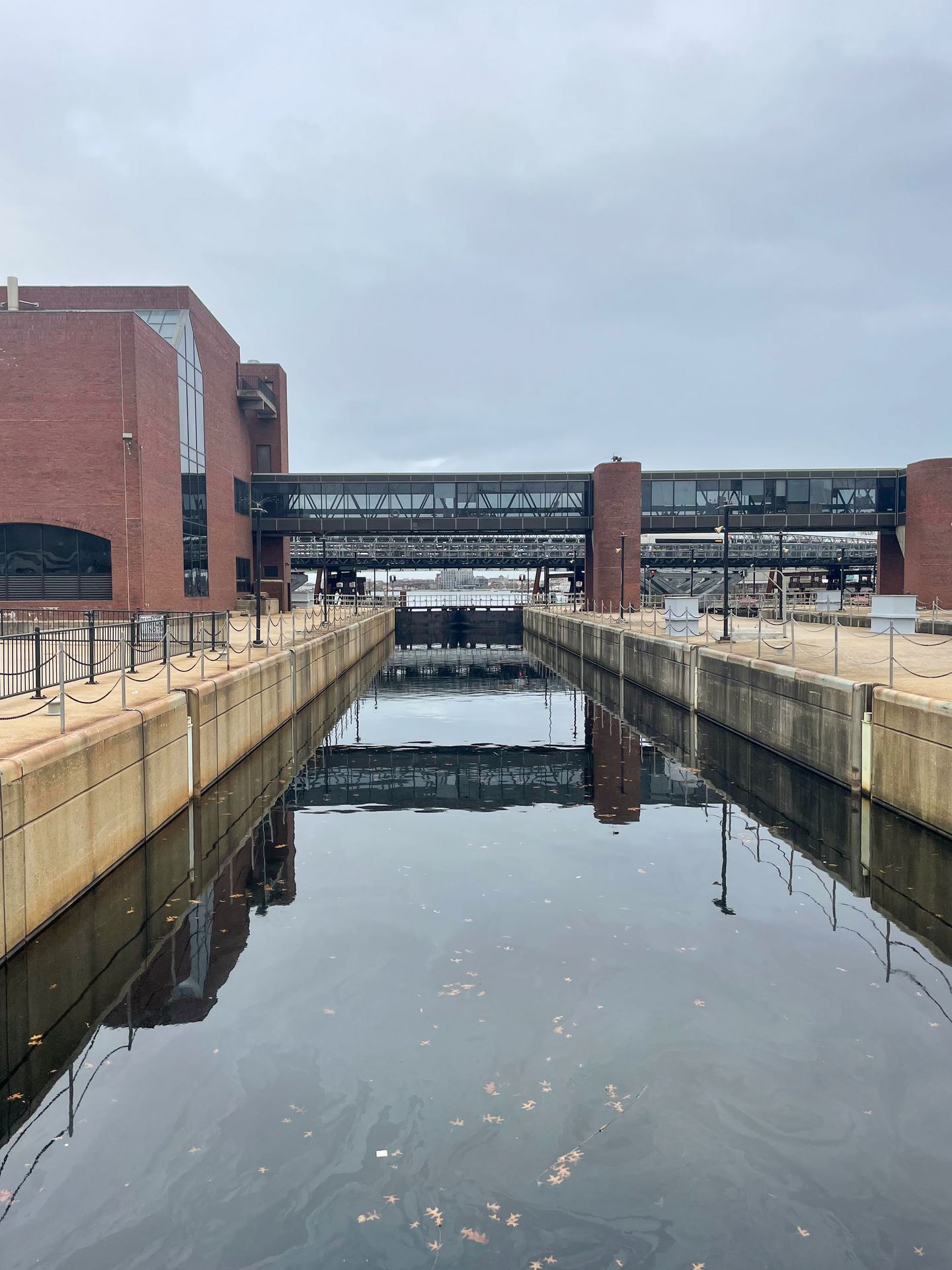
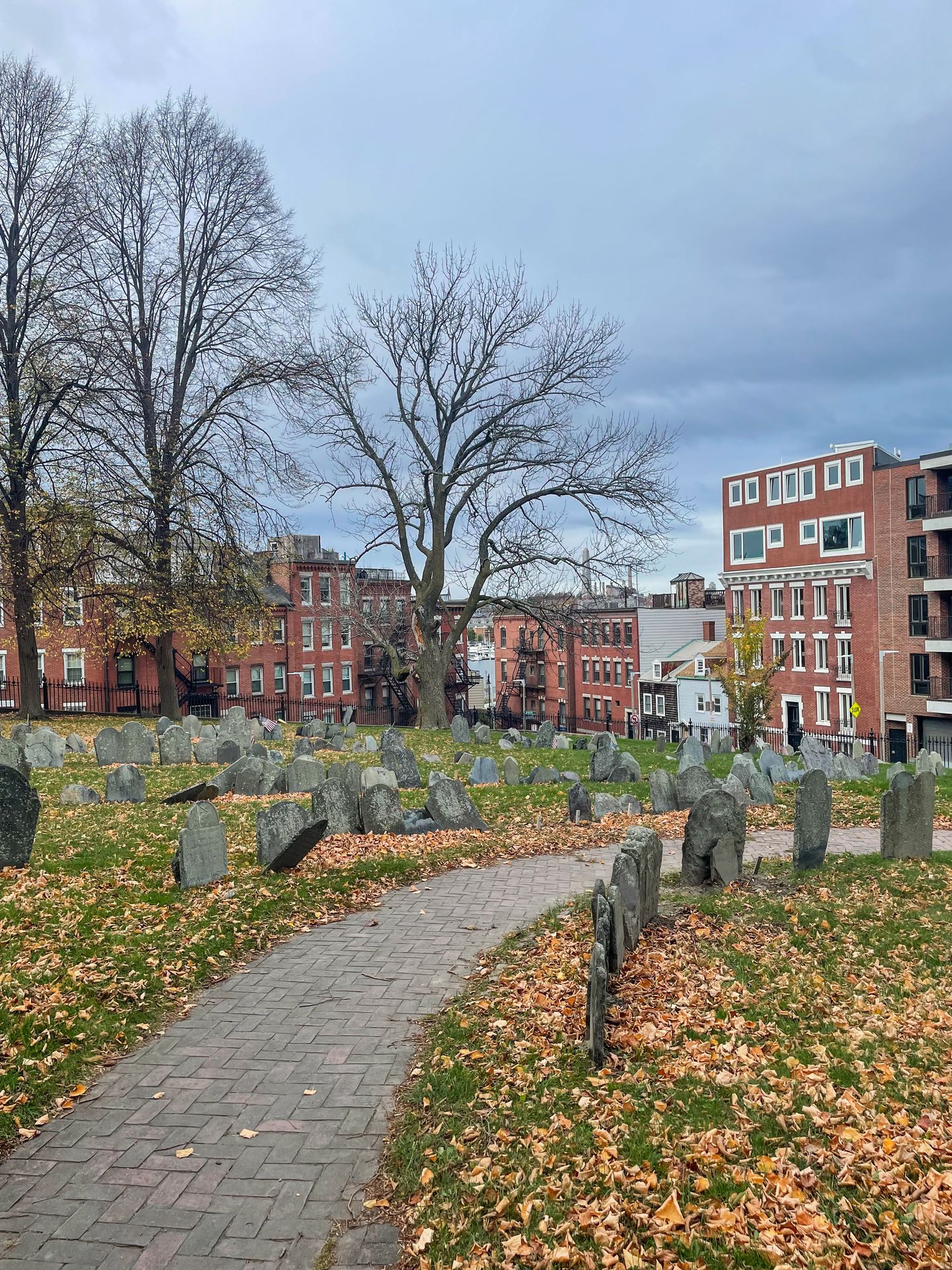
USS Constitution
The USS Constitution site features two ships: the USS Constitution and the USS Cassin Young. This is a National Park Site and you can go inside both of the ships, plus there is a museum to explore.
Visiting the National Park Site involves going through security. Then, you’ll begin inside a museum and gift shop area before walking outside to explore both the USS Constitution and the USS Cassin Young.
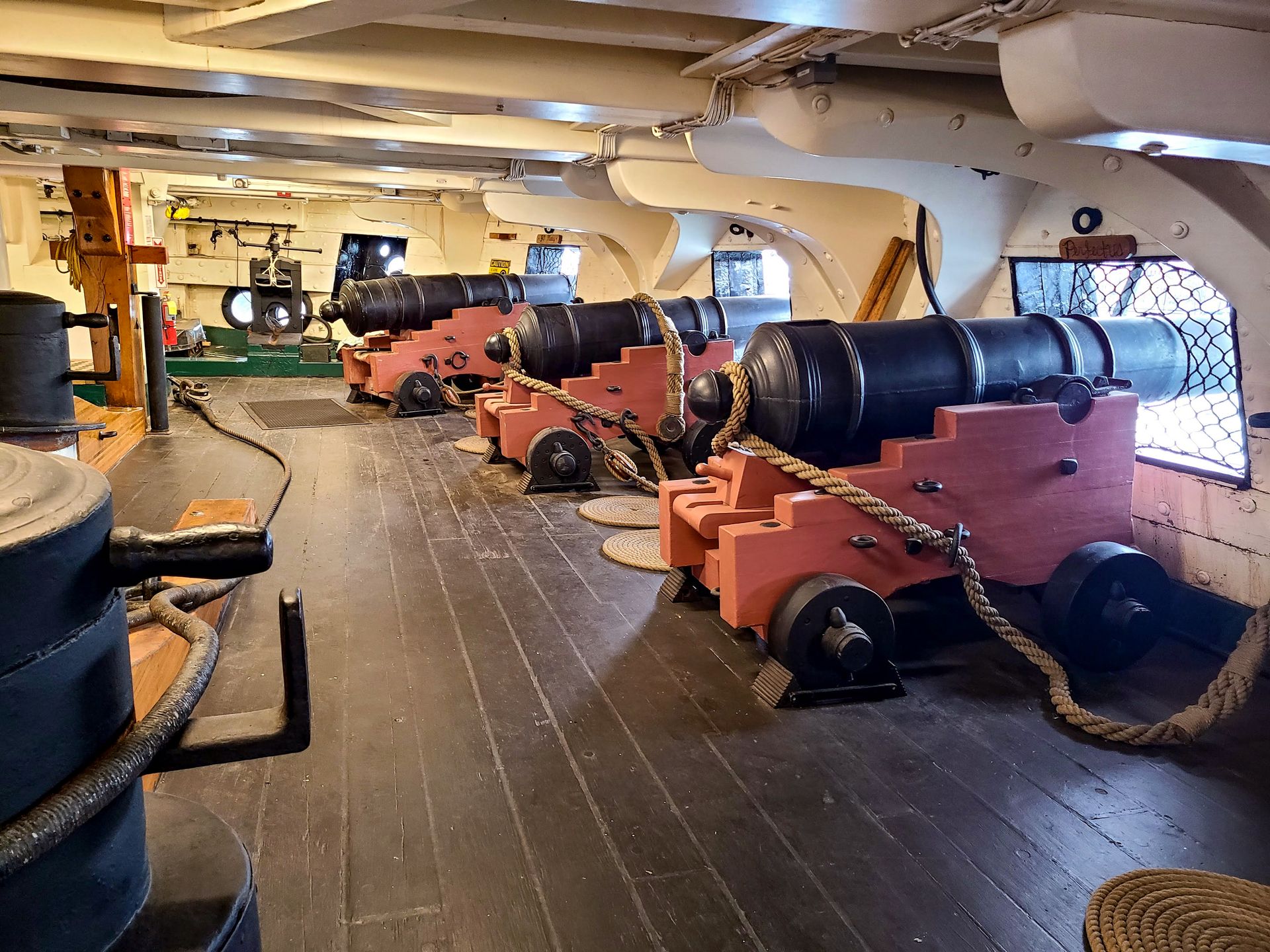
The USS Constitution is the world’s oldest commissioned warship that is still afloat and is still operated by the United States Navy. On board, you can explore three levels and see the cannons, where the soldiers slept and ate, and more. There are steep stairs to descend between the various levels.
Fun Fact: The nickname of the USS Constitution is “Old Ironsides.”
The USS Cassin Young was a destroyer from WWII. It’s interesting to compare this much more modern ship to the USS Constitution.
The USS Constitution Museum is right next to the ships and has exhibits covering the history of the USS Constitution. There are some interesting artifacts to see and some interactive areas great for kids. The museum is donation based but they recommend $10-$15 per person.
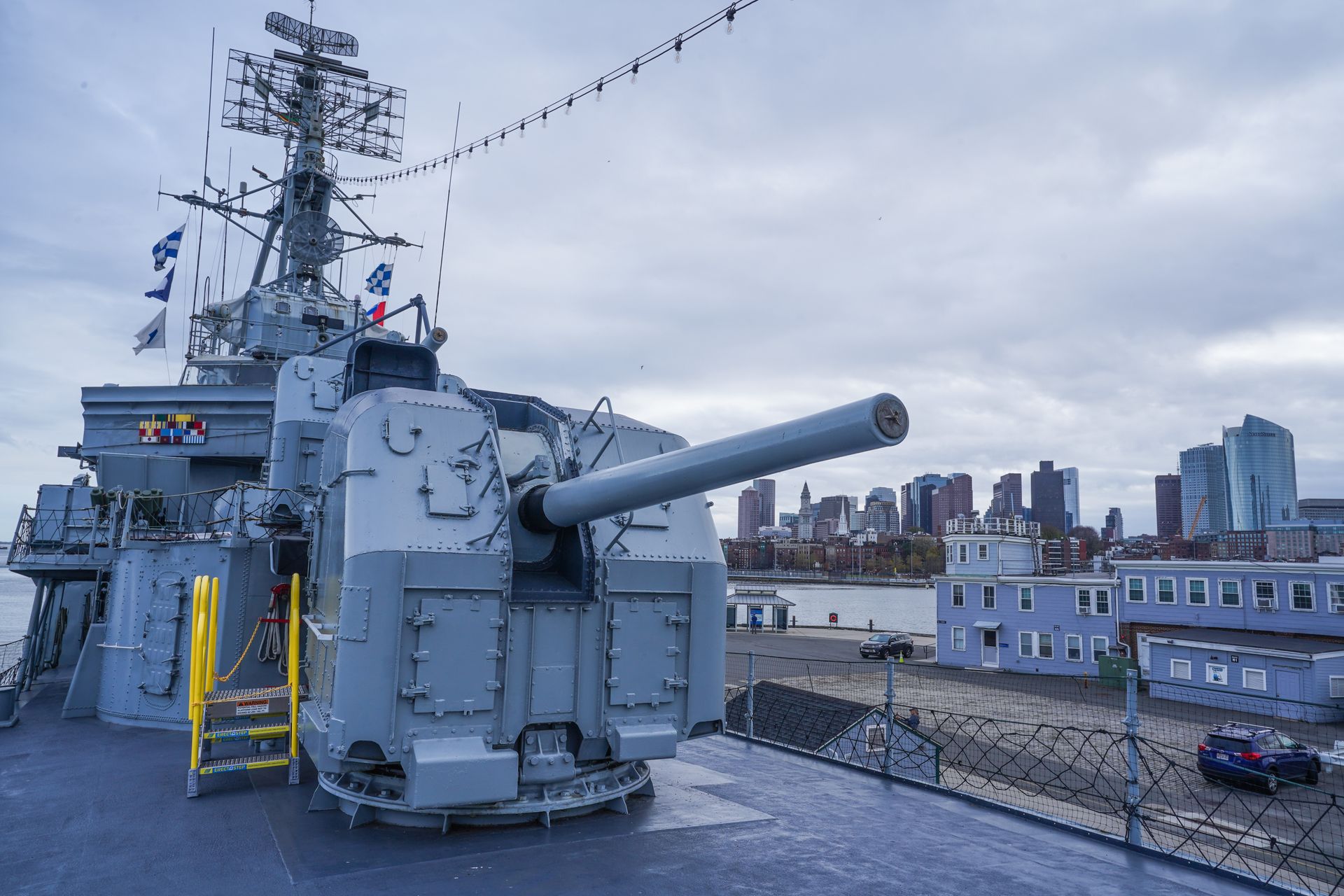
Bunker Hill Monument
It’s a bit of a walk to reach the final stop on the Freedom Trail: the Bunker Hill Monument. The site is a half mile away from the USS Constitution.
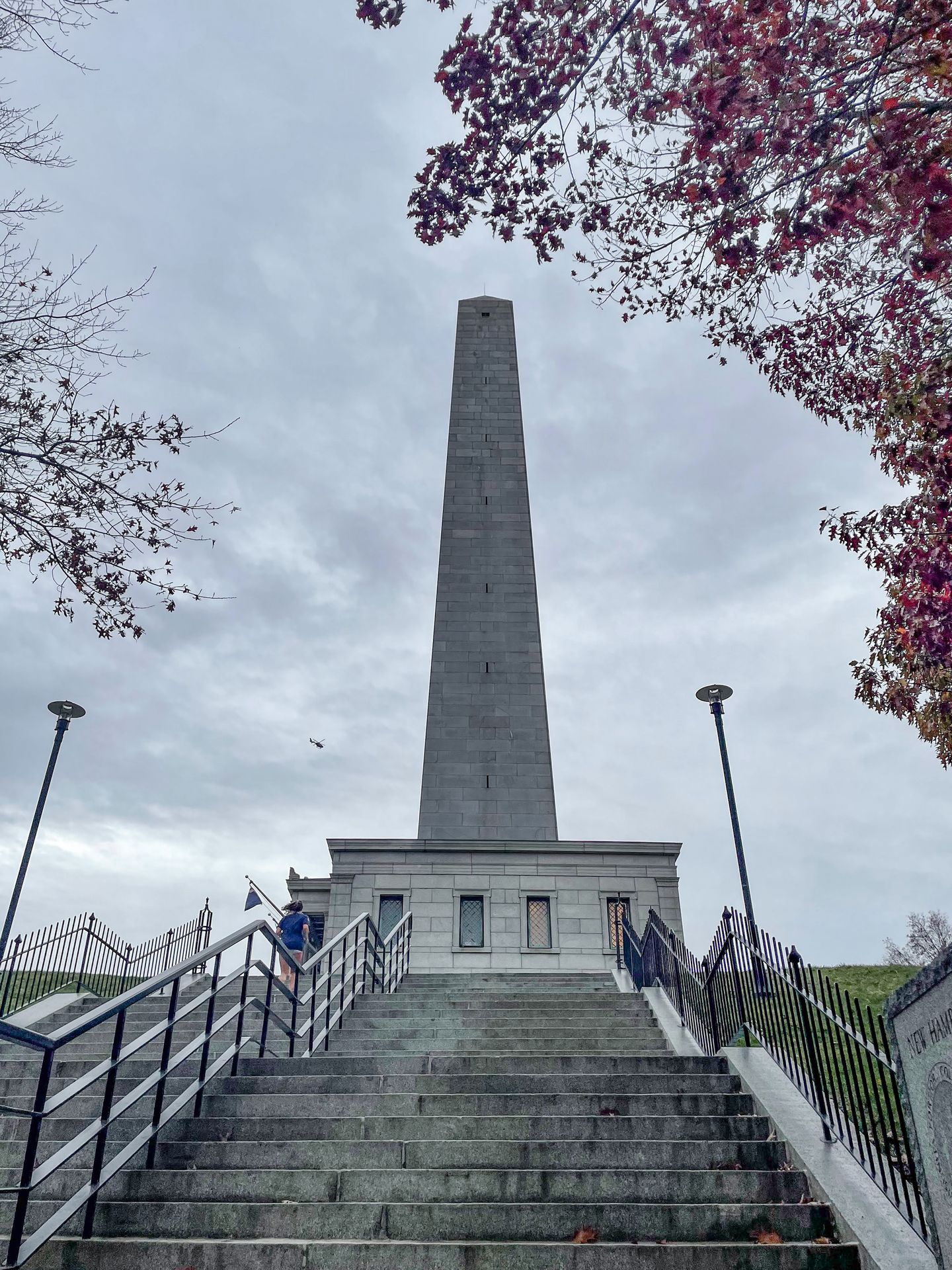
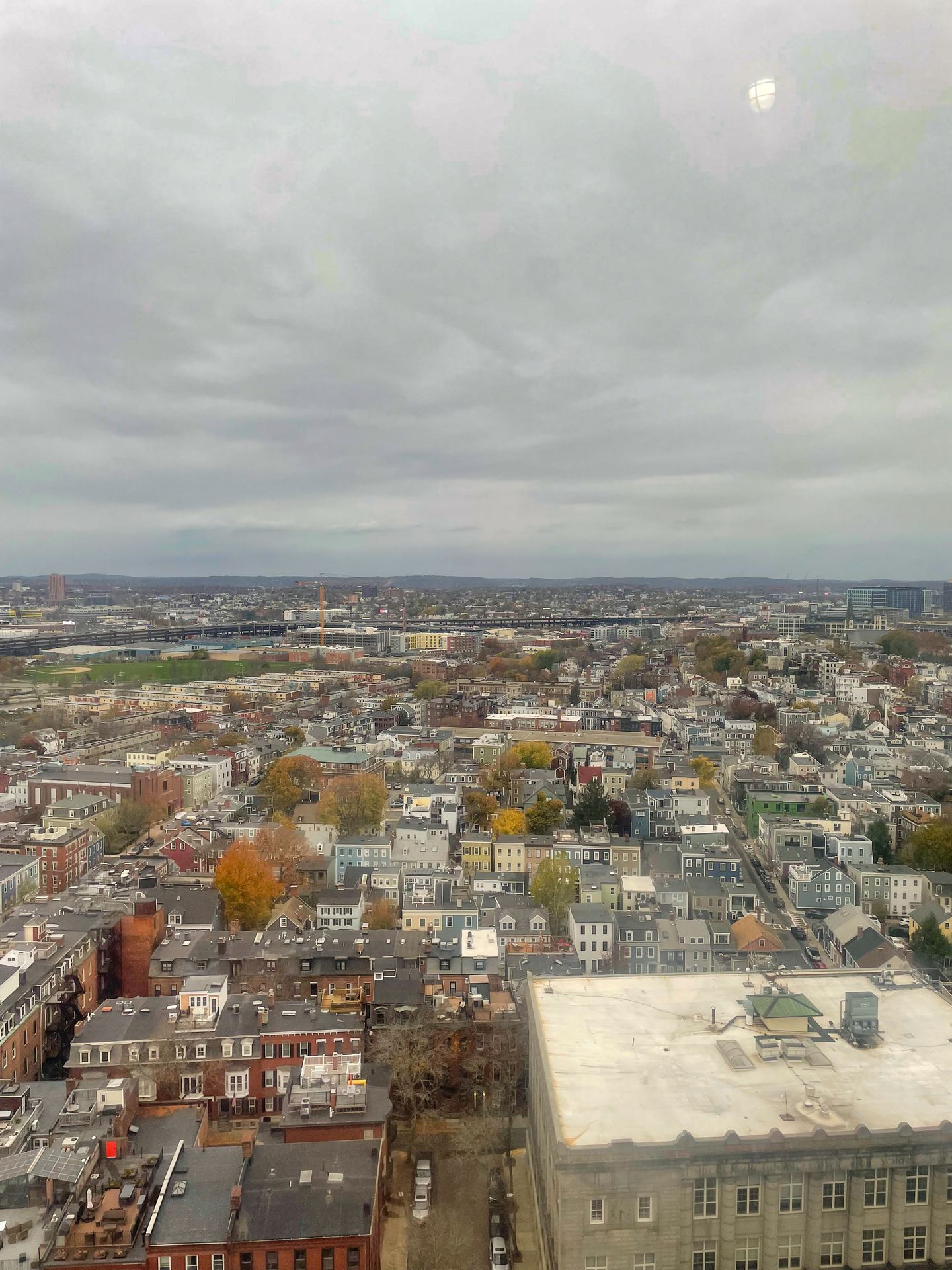
The Bunker Hill Monument honors the site of the Battle of Bunker Hill, the first major battle in the Revolutionary War.
The monument was built 50 years after the battle and is a 221-foot tall obelisk. To reach the top, you’ll climb 294 steps in a bit of a tight and dark staircase.
It’s neat to reach the top, but the windows are small with glass and screens over them, so you won’t get a fantastic view. But it’s still worth climbing up to see for yourself!
The tower is free to visit and there are some artifacts to view at the base of the tower.
Tips for Walking the Boston Freedom Trail
- Bring water and snacks, plus good walking shoes! While the walk isn’t difficult, you’ll be on your feet for a while. It’s also smart to carry a portable phone battery.
- Most stops on the Freedom Trail are free, but some have fees to enter into the buildings and learn more. However, most of the entrance fees are affordable.
- I walked the Freedom Trail in one direction and then took public transportation to get back to the center of the city.
Read my one day Boston itinerary to learn more about visiting this historic city!
More Things To Do in Boston
While the Freedom Trail is one of the best things to do in Boston, here are my other favorite activities for a great weekend itinerary.
- Visit the Boston Tea Party Museum
- Visit the Boston Public Library
- Visit the beautiful Acorn Street in Beacon Hill
- Eat Italian food in the North End (Boston’s Little Italy)
- Visit the Isabella Gardner Museum (an infamous art heist took place here)
Final Thoughts
I hope this guide helps you plan out your visit to the Freedom Trail in Boston. Whether you’re a history buff or just looking to learn a bit more about the tension that led to the American Revolutionary War, this is a great activity in Boston for anyone.
More New England and New York Guides:
- How to Spend the Perfect Day in Boston
- How to Spend One Day in Salem, MA
- An Epic 10 Day New England Road Trip
- The Best Hiking near Ithaca, New York
- 7 Day Vermont and New Hampshire Fall Itinerary
- The Best Hiking Trails in Acadia National Park
- The Ultimate Fall Guide to Acadia National Park
- The Perfect Day Trip to Connecticut
- The Best Things To Do in North Adams, MA
Thanks for Reading!
Let's stay in touch!
Join the Lost with Lydia email list to get monthly travel guides and tips!
